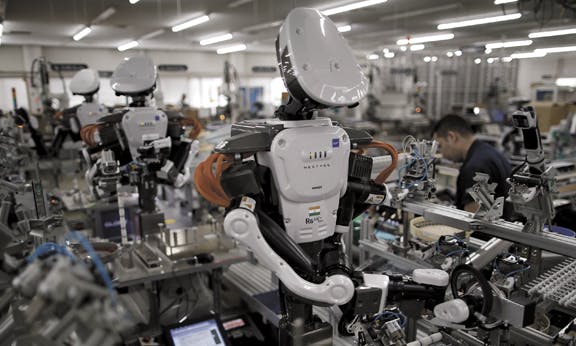Are the robots coming for your job?

When Henry Ford showed Walter Reuther, the veteran leader of the United Automobile Workers (UAW) union, around a newly automated car plant, he reportedly asked, “Walter, how are you going to get those robots to pay your union dues?”
“Henry, how are you going to get them to buy your cars?”, Reuther replied.
Reuther and the UAW could not stop the robots – tens of thousands of car workers have been replaced by machines since then. But workers haven’t always lost in the battle over new technology. Medical, scientific and social advances have brought great benefits and many new industries and associated jobs.
Today, we face what many are calling the Fourth Technological Revolution – a sea change in production based on the internet, robots and artificial intelligence, which might wipe out 40 percent of today’s jobs. Will we go through disruption similar to the Industrial Revolution of the 1800s?
Capitalism both creates and destroys in an unplanned and chaotic way: destroying lives through unemployment and millions of mindless jobs, at the same time opening possibilities for new and better jobs and a better life.
Each new technological development brings these contradictory outcomes.
Computerisation put a lot of printers out of work. But we now have many new jobs enabled by it, such as web designers. The introduction of ATMs, which many thought would replace bank tellers, has led to a greater number of ATMs and bank tellers. Their jobs have been redefined to include a range of higher skilled tasks.
In the US, the Pew Research Center reported in 2014 that the number of IT jobs in industry, administration and services increased by 77 percent between 1997 and 2012.
There are downsides. Some tasks are not easily transferred to the tech sector, leaving many unemployed. There are few plans to retrain workers, so they are left to fend for themselves. The new jobs can be precarious, with low pay and poor conditions, such as Uber and Airtasker. New areas of work are un-unionised, sometimes forcefully so.
Change is constant. While only 10 percent of US manufacturing is currently robotised, it could reach 45 percent by 2025. White collar jobs – from clerks and financial analysts to librarians and surgeons – are the next frontier, with almost 50 percent of jobs threatened.
In Australia the estimate is around 4.6 million jobs out of a workforce of roughly 11 million.
However, the impact on employment is contradictory and complex. Unemployment levels have hovered around 4-6 percent in most developed countries. And most studies show that the majority of workers in the advanced economies are still in permanent full time or part time employment, with the proportion of casualised or precarious jobs staying the same.
Paul Karp pointed out in the Guardian last year that independent contractors have remained at about 10 percent of the Australian workforce for the past 15 years. Many of those taking up work at companies such as Uber are already working full time or permanent part time or are retirees topping up their income. This is a pattern that has a long history.
Alexandra Heath from the Reserve Bank, in a study of change over the 30 years to 2016, estimated that the share of routine jobs fell 14 percent and non-routine jobs rose by 14 percent. The share of manual jobs has fallen by 5 percent, while the share of “cognitive jobs” (such as secretaries, bookkeepers and office workers) has risen by the same amount.
So the situation for now is that, while work is increasingly automated, there aren’t mass job losses, nor are most people catapulted into precarious jobs with no future. While new technology eliminates jobs, it does not eliminate work itself – at each changeover, new jobs have been created using the most recent technology.
The new world of work isn’t the threat to workers; it’s how the ruling class organises and controls work, the decisions they make in the interests of profit, that determine whether robots and artificial intelligence will destroy or damage the lives of millions or improve life and work.
In the 19th century, Charles Babbage, the inventor of the precursor of computers, wrote about the organisation of work in machine-dominated factories. He was followed by Frederick Taylor, who wrote about “scientific management” in the early 20th century. Both argued for reorganising every detail of the work process, assigning workers to one or two tasks and giving ultimate control of the work process to employers.
Without these things, they said, the efficiencies and financial benefits of factory production would be lost to the ruling class. Taylorism, as it came to be known, used by the Ford Motor Company, is the classic example.
But workers have always resisted. From the Luddites, famous for smashing the machines of the textile factories in the early 1800s, to Australia’s 1917 national strike, which began at Eveleigh Rail Yards in Sydney over the introduction of timecards, to struggles in logistics today, there has always been a contest over control of the workplace.
We can see the potential of the logistics and new tech workers of today – such as Polar Fresh in Victoria, Amazon workers in Germany and Verizon employees in the US – when workers rise up time and again to challenge capitalism. These workers bring with them the promise of a better world. As the 2015 national conference of Australia’s United Voice union concluded:
“Technology is a key driver in the changing work of our members. We need to do more than embrace it. We need to adopt an aggressive, future-oriented and proactive stance on technology. It’s not the robots we should be afraid of, it’s our inaction.”